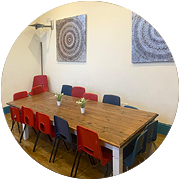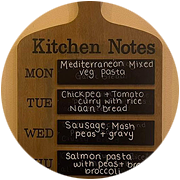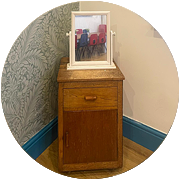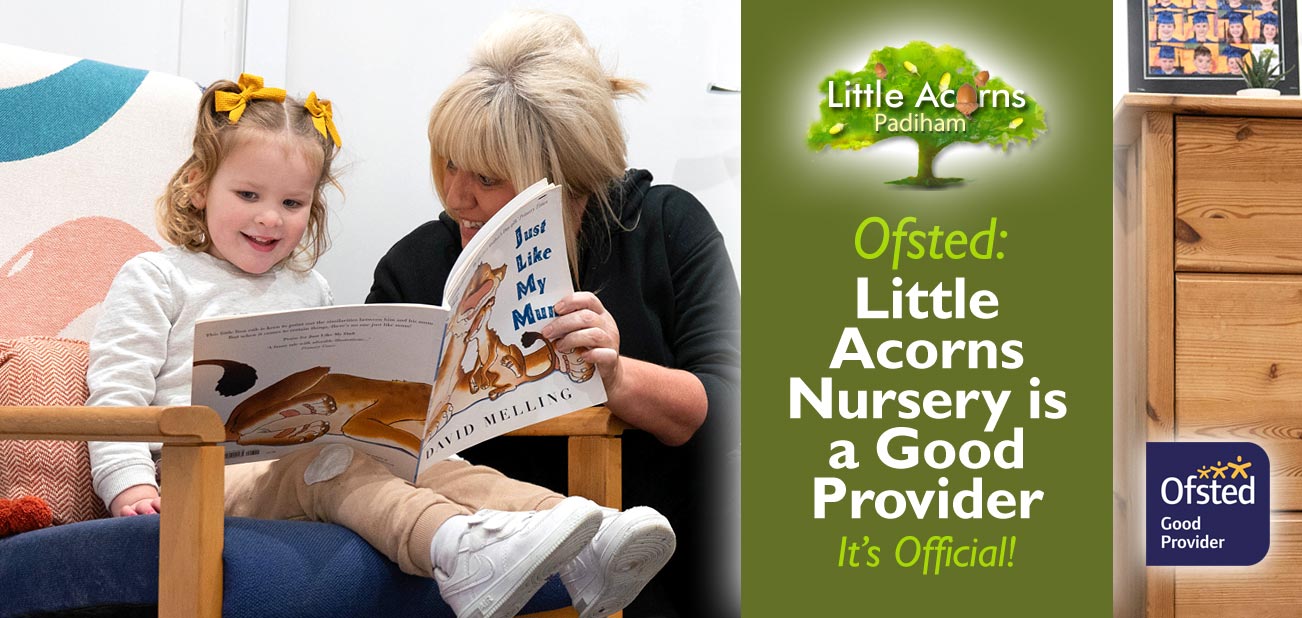
 We’re delighted to announce that Ofsted has published a stunning report for Little Acorns Nursery, Padiham. It’s now official that this excellent Padiham childcare setting is a ‘Good Provider’ — in every category! What’s more, the Ofsted inspector published some wonderfully positive comments about the nursery, staff, and quality of care as part of the report. Their findings are a testament to the high quality of the setting, the professionalism of its early years practitioners and leadership, and the positive impact the nursery has on babies and children in its care. Today, we take a deep dive into the details.
We’re delighted to announce that Ofsted has published a stunning report for Little Acorns Nursery, Padiham. It’s now official that this excellent Padiham childcare setting is a ‘Good Provider’ — in every category! What’s more, the Ofsted inspector published some wonderfully positive comments about the nursery, staff, and quality of care as part of the report. Their findings are a testament to the high quality of the setting, the professionalism of its early years practitioners and leadership, and the positive impact the nursery has on babies and children in its care. Today, we take a deep dive into the details.
• Overall effectiveness: Good
• The quality of education: Good
• Behaviour and attitudes: Good
• Personal development: Good
• Leadership & management: Good
A Welcoming, Safe & Secure Environment for ChildrenIn her report, the Ofsted inspector recognised the warm, welcoming, safe and secure nature of the setting and early years practitioners:
Such a positive environment and approach by staff is clearly being reflected in the children:
|
Independence & Self-Confidence in Little OnesThe inspector also had positive comments about children learning new skills, gaining in confidence, and becoming more independent — important for when they transition to school. Helped by “high aspirations for what children can do,” Ofsted follows up by saying “The expectations are well sequenced throughout the nursery, helping to build on children’s skills over time.” Ofsted remarked that “From babies upwards, they encourage children to have a go” and, as a result…
|
The Nursery’s Approach to the Early Years CurriculumThe Ofsted inspector seemed particularly impressed with the nursery’s approach to the early years curriculum, remarking that:
Targeted staff training, focused on the needs of the children, was also seen to be part of this success, with the Ofsted inspector commenting that it “has positively impacted on the implementation of the curriculum.” Indeed, the success of such an approach was seen to be working well right across the nursery, boosting children’s learning:
Assessment of children’s progress was also highly praised:
|
What About Children with SEND?The approaches outlined above were seen to apply well to children who may need extra support and those with special educational needs and/or disabilities:
Parents spoken to by the Ofsted Inspector also appreciated the nursery’s approach to extra help for children, including those with SEND:
|
Children’s Communication & LanguageOfsted recognised the nursery’s approach to boosting children’s language and communication skills in their report too. The inspector commented on our staff:
|
Children’s Learning StepsOfsted’s inspector praised Little Acorns’ staff in their approach to learning steps, commenting:
The inspector went on to say that such activities and experiences help to “build on children’s knowledge” and then gave some examples. |
Reading & Writing at Little AcornsThe Ofsted inspector commented favourably about the way in which staff at Little Acorns Nursery support the learning of the skills necessary to read and write. Children are also encouraged to develop a natural and active interest in books and reading. The inspector wrote, “Children are provided with the opportunities to develop the skills they will need for later writing” and “Leaders value the importance of providing lots of opportunities for children to enjoy stories. They provide a wide range of books for children to explore.” Coordination and dexterity were noted to be an important part of these successes:
Ofsted recognised that staff “Staff support children’s hand-eye coordination superbly. They have consulted with the local schools and used this to enhance the curriculum to ensure children develop the dexterity needed to support later writing.” |
Behaviour & Emotional Regulation at the NurseryDuring their visit, Ofsted recognised that children behaved well and that their emotional regulation skills were being nurtured appropriately by the nursery’s practitioners:
|
Healthy Lifestyles & Good ChoicesThe Ofsted inspector noted in her report that:
She pointed out that “Children benefit from many experiences to play outside in the fresh air and by walking in the community.” Also, in regard to healthy eating, she remarked: “Staff talk to children at mealtimes about the impact of food on their bodies. Children are beginning to know how to keep their bodies healthy. They talk about the need to keep their bodies hydrated and check that their friends have also had a drink of water.” Ofsted also recognised that children’s kindness is reflected in their treatment of the environment:
|
Effective SafeguardingOne of the most important things at any nursery is, of course, to keep children safe and well. Little Acorns Nursery scored well in this regard too, with the Ofsted inspector reporting that “the arrangements for safeguarding are effective” and:
|
Good Provision
It’s wonderful that Ofsted has recognised the hard work and professionalism at Little Acorns Nursery, Padiham. It’s clear that it’s benefiting children and enabling them to be as school-ready as possible by the time they leave us around the age of five. And, if there are areas we can still improve on, we will implement such measures without delay — all with a view to making children’s experiences at the nursery simply outstanding!
A Nursery Place for Your Child at Little Acorns
High-quality childcare in Padiham — for babies (3m+) and children under 5
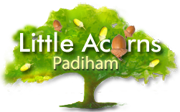
 If you like the sound of the Ofsted inspector’s comments and need high-quality weekday childcare in Padiham, Lancashire, get in touch. You can register for a place, request a guided tour with your child, or ask us any questions. We’re here to help and would love to meet you and your child! We also support free, government-funded childcare places for eligible children as young as just 9 months of age.
If you like the sound of the Ofsted inspector’s comments and need high-quality weekday childcare in Padiham, Lancashire, get in touch. You can register for a place, request a guided tour with your child, or ask us any questions. We’re here to help and would love to meet you and your child! We also support free, government-funded childcare places for eligible children as young as just 9 months of age.
Little Acorns Nursery is located in Padiham (Lancashire), so is just a stone’s throw away for families living in Hapton, Rose Grove, Burnley, Altham, Huncoat, Read, Simonstone, Sabden, Higham and Wood End. If you need weekday childcare, come and see us – we’d love to meet you!
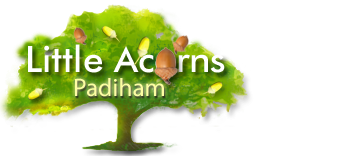
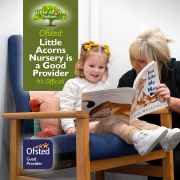
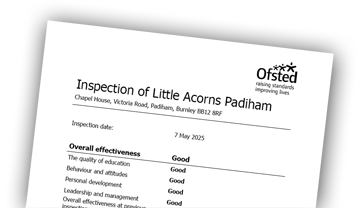

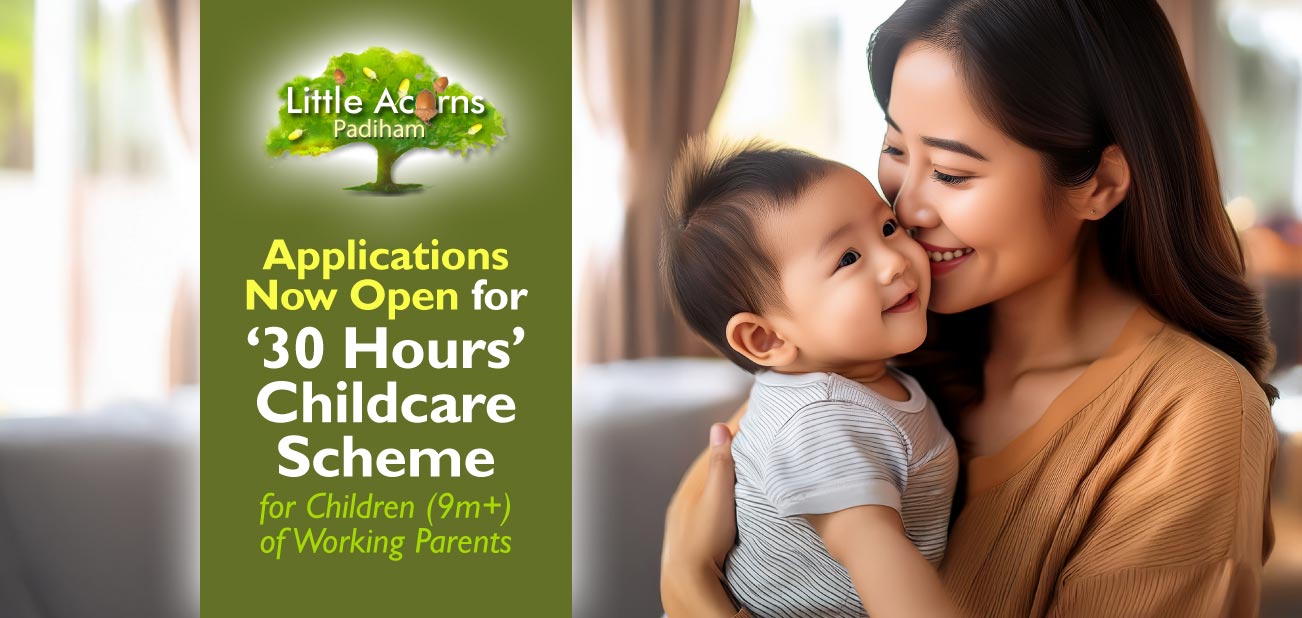
 Attention working families: applications are now open for eligible children, aged from only 9 months, to receive 1140 hours of free childcare per year from September 2025. What’s noteworthy is that this will be the first time such young infants and toddlers can access so many free hours. It effectively doubles the number of free childcare hours previously available to those under 2 via the scheme. The new, extended funding is for eligible working families, who now have until the 31st of August to apply if they would like their child(ren) to start in the September 2025 term.
Attention working families: applications are now open for eligible children, aged from only 9 months, to receive 1140 hours of free childcare per year from September 2025. What’s noteworthy is that this will be the first time such young infants and toddlers can access so many free hours. It effectively doubles the number of free childcare hours previously available to those under 2 via the scheme. The new, extended funding is for eligible working families, who now have until the 31st of August to apply if they would like their child(ren) to start in the September 2025 term. This newly extended scheme will be profoundly beneficial to parents, children, the business world, and the economy. Let’s take a look:
This newly extended scheme will be profoundly beneficial to parents, children, the business world, and the economy. Let’s take a look: The funded childcare is for children of working parents with earnings within the specific range outlined below. Under this scheme, children receiving the free hours from the September 2025 term must be aged no less than 9 months old on 1st September 2025 and free funding for those who remain eligible is available right up until school age.
The funded childcare is for children of working parents with earnings within the specific range outlined below. Under this scheme, children receiving the free hours from the September 2025 term must be aged no less than 9 months old on 1st September 2025 and free funding for those who remain eligible is available right up until school age. As our families regularly confirm, Little Acorns in Padiham is a highly-regarded childcare nursery that attracts
As our families regularly confirm, Little Acorns in Padiham is a highly-regarded childcare nursery that attracts 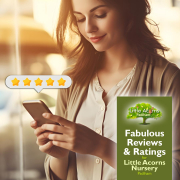


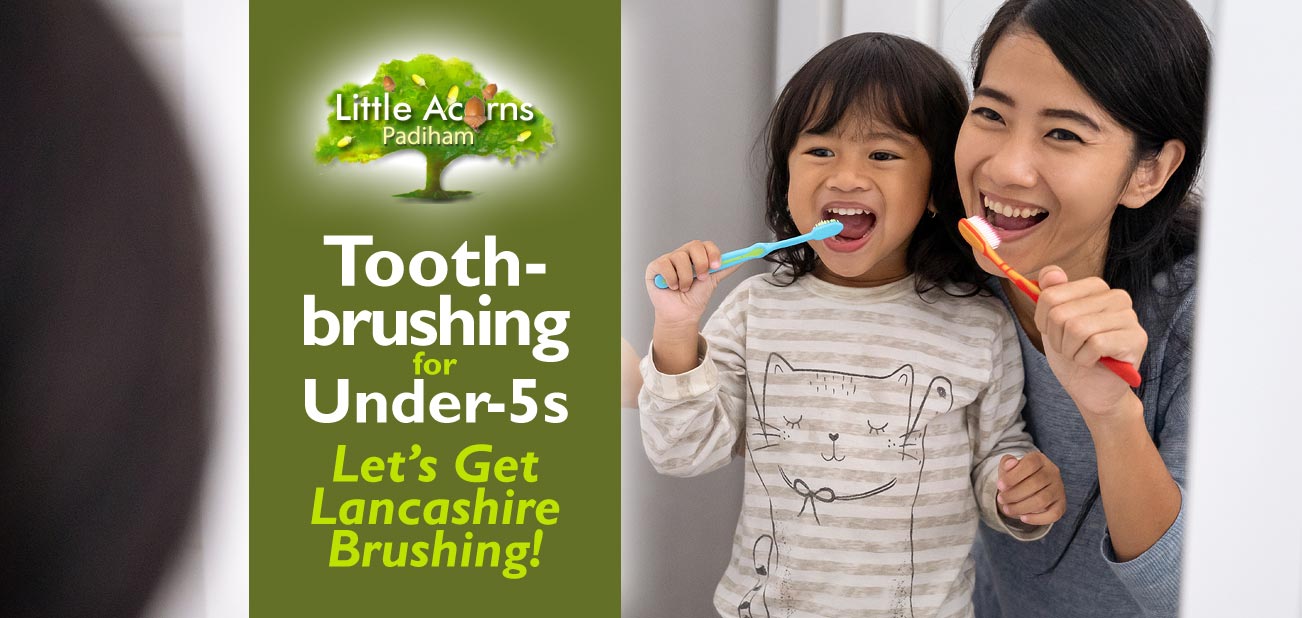
 Today we bring you a guide to toothbrushing for under-fives, inspired by children at Little Acorns Nursery taking part in Lancashire’s Let’s Get Lancashire Brushing campaign. An initiative of Lancashire County Council Public Health, the programme is designed to educate and encourage young children, including toddlers, to brush teeth for 2 minutes twice a day using age-appropriate toothpaste. What’s more, their message is that it’s never too young to begin and can even start before the first tooth has surfaced. At Little Acorns Nursery, the programme is supervised by staff and is intended to take place in tandem with toothbrushing at home — it does not replace it. Nursery staff guide children to establish a positive and proactive routine around toothbrushing, to foster good habits around oral hygiene, and thereby minimise tooth decay and problems associated with it.
Today we bring you a guide to toothbrushing for under-fives, inspired by children at Little Acorns Nursery taking part in Lancashire’s Let’s Get Lancashire Brushing campaign. An initiative of Lancashire County Council Public Health, the programme is designed to educate and encourage young children, including toddlers, to brush teeth for 2 minutes twice a day using age-appropriate toothpaste. What’s more, their message is that it’s never too young to begin and can even start before the first tooth has surfaced. At Little Acorns Nursery, the programme is supervised by staff and is intended to take place in tandem with toothbrushing at home — it does not replace it. Nursery staff guide children to establish a positive and proactive routine around toothbrushing, to foster good habits around oral hygiene, and thereby minimise tooth decay and problems associated with it.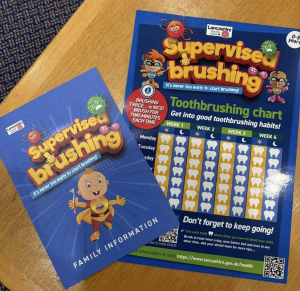
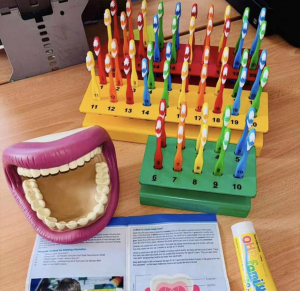
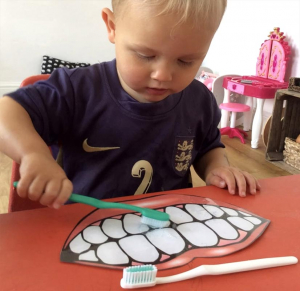
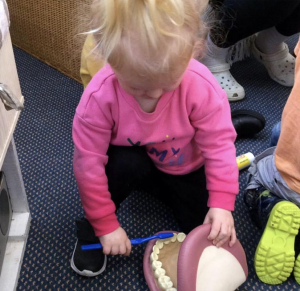

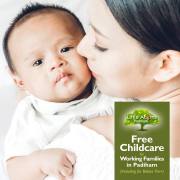
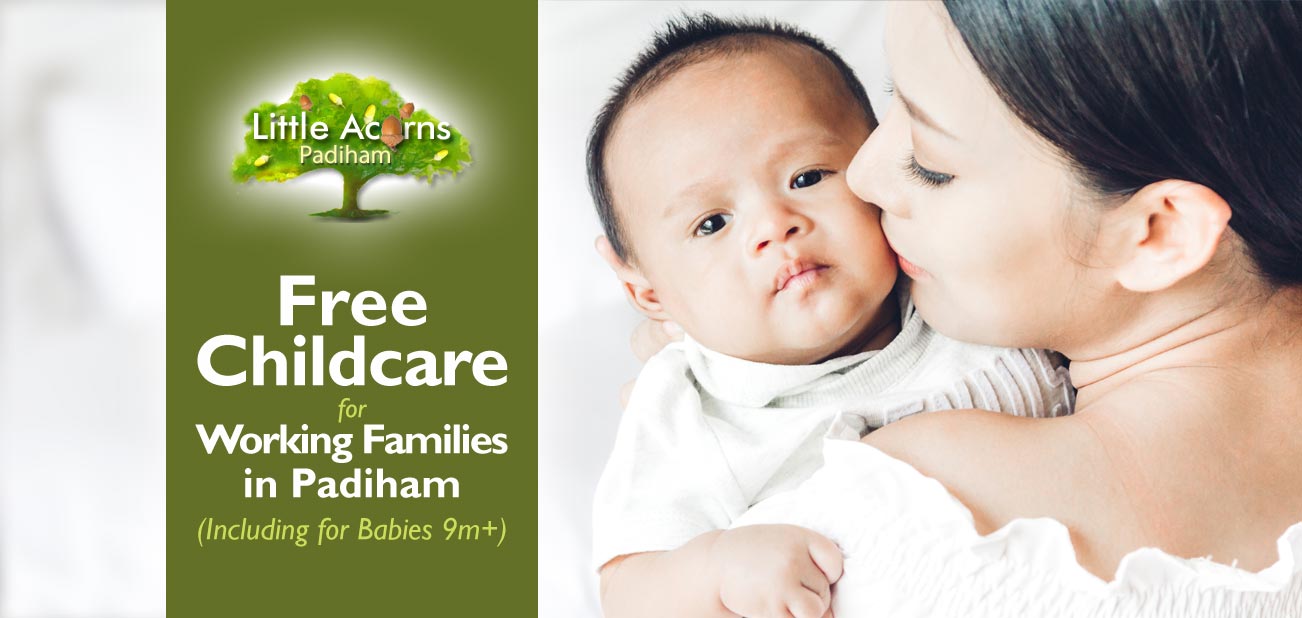
 Today, we remind Padiham families that Little Acorns Nursery supports the new — free — childcare scheme for eligible children including babies as young as just 9 months of age. Although it’s available only to eligible working families, the bar to entry is fairly low. The childcare funding is therefore attainable for many families. This free childcare is not just limited to babies either and, what’s more, it’s due to become even more generous from September 2025. In our guide below we’ll outline who is eligible, how much childcare funding they can access, how many childcare hours that equates to, and what the eligibility criteria are. If you’re the parent of a baby, toddler, or child up to three years old, this is for you.
Today, we remind Padiham families that Little Acorns Nursery supports the new — free — childcare scheme for eligible children including babies as young as just 9 months of age. Although it’s available only to eligible working families, the bar to entry is fairly low. The childcare funding is therefore attainable for many families. This free childcare is not just limited to babies either and, what’s more, it’s due to become even more generous from September 2025. In our guide below we’ll outline who is eligible, how much childcare funding they can access, how many childcare hours that equates to, and what the eligibility criteria are. If you’re the parent of a baby, toddler, or child up to three years old, this is for you. For those working families who are eligible, the scheme provides 570 hours per year of free childcare to children aged from 9 months to 3 years. This is normally taken as 15 hours per week for 38 weeks, usually aligning with the standard educational term-time weeks for school timetables. That said, it may be possible to stretch the hours over more weeks of the year if your childcare provider is able to accommodate such flexibility.
For those working families who are eligible, the scheme provides 570 hours per year of free childcare to children aged from 9 months to 3 years. This is normally taken as 15 hours per week for 38 weeks, usually aligning with the standard educational term-time weeks for school timetables. That said, it may be possible to stretch the hours over more weeks of the year if your childcare provider is able to accommodate such flexibility. We’ll try to simplify the eligibility criteria for you. Whether it’s for a baby aged 9 months, a toddler of 1 or 2, or a child aged 3 or 4, there are essentially four main criteria for this specific type of childcare funding:
We’ll try to simplify the eligibility criteria for you. Whether it’s for a baby aged 9 months, a toddler of 1 or 2, or a child aged 3 or 4, there are essentially four main criteria for this specific type of childcare funding: Well, it’s good news. It’s already the case that all 3 and 4-year-olds living in England are eligible to receive 570 hours (15 per week) of free childcare anyway. That’s available under what’s known as ‘Universal Entitlement’, a Government childcare funding scheme that’s been around for some time. What’s more, those working families that are eligible for the ‘new’ free childcare for children aged 9 months to 3 years are also likely to be eligible for a top-up of their child’s Universal Entitlement once they reach the ages of 3 and 4. In those cases, they’ll be entitled to 30 hours per week over 38 weeks (or however the 1140 free hours are spread out). That’s because the eligibility criteria are the same (see section above).
Well, it’s good news. It’s already the case that all 3 and 4-year-olds living in England are eligible to receive 570 hours (15 per week) of free childcare anyway. That’s available under what’s known as ‘Universal Entitlement’, a Government childcare funding scheme that’s been around for some time. What’s more, those working families that are eligible for the ‘new’ free childcare for children aged 9 months to 3 years are also likely to be eligible for a top-up of their child’s Universal Entitlement once they reach the ages of 3 and 4. In those cases, they’ll be entitled to 30 hours per week over 38 weeks (or however the 1140 free hours are spread out). That’s because the eligibility criteria are the same (see section above).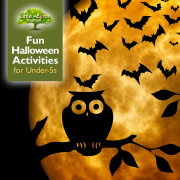
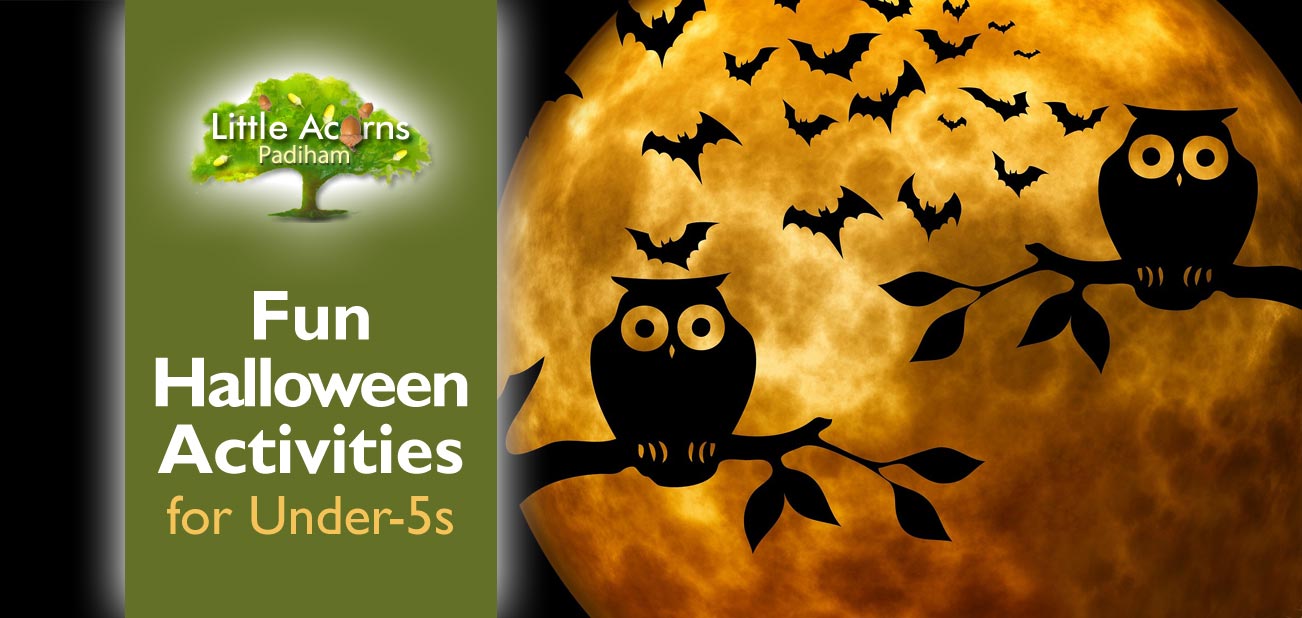
 Let’s get ready for some fun Halloween activities for our under-5s — as well as for older children. Children of all ages are naturally drawn to the unique imagery, fun activities, and spookiness of Halloween.
Let’s get ready for some fun Halloween activities for our under-5s — as well as for older children. Children of all ages are naturally drawn to the unique imagery, fun activities, and spookiness of Halloween. A simple but fun activity for children in the run-up to Halloween is to pick pumpkins. Whether it’s simply a case of visiting a local garden centre or store to choose a pumpkin from a themed display, or visiting a local farm where children can search for a favourite pumpkin in fields laden with them, it’s great fun for little ones. Children are sure to enjoy choosing from the usually huge array of different sizes and shapes.
A simple but fun activity for children in the run-up to Halloween is to pick pumpkins. Whether it’s simply a case of visiting a local garden centre or store to choose a pumpkin from a themed display, or visiting a local farm where children can search for a favourite pumpkin in fields laden with them, it’s great fun for little ones. Children are sure to enjoy choosing from the usually huge array of different sizes and shapes.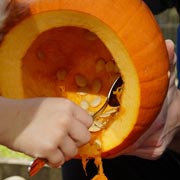 Once your child has a pumpkin or other gourd, it’s almost imperative that it’s carved (by a supervising adult) and made into what Americans call a Jack-O’-Lantern. Many families will be totally familiar with these, typically being a hollowed-out pumpkin with eyes, a nose, and a mouth — or indeed other kinds of design as indicated in the accompanying image. Children can be involved in the design, painting with paint if going that route, and perhaps spooning out the inside flesh (keep for later; see the food and drink section below).
Once your child has a pumpkin or other gourd, it’s almost imperative that it’s carved (by a supervising adult) and made into what Americans call a Jack-O’-Lantern. Many families will be totally familiar with these, typically being a hollowed-out pumpkin with eyes, a nose, and a mouth — or indeed other kinds of design as indicated in the accompanying image. Children can be involved in the design, painting with paint if going that route, and perhaps spooning out the inside flesh (keep for later; see the food and drink section below).  However, any cutting will be too dangerous for little ones, so should be done only by an adult. It’s the same with the next step, which is lighting a candle or tea light to put inside once it’s dark. The pumpkin lanterns can then be placed outdoors for neighbours and friends to see and the children themselves will find these fascinating once night falls. They make for a great atmosphere and a bit of spookiness!
However, any cutting will be too dangerous for little ones, so should be done only by an adult. It’s the same with the next step, which is lighting a candle or tea light to put inside once it’s dark. The pumpkin lanterns can then be placed outdoors for neighbours and friends to see and the children themselves will find these fascinating once night falls. They make for a great atmosphere and a bit of spookiness!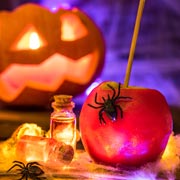 Children will also love spreading the Halloween theme around the house. This activity is made easy by purchasing inexpensive Halloween decorations that are available commercially in places like supermarkets each October. Whether it’s cotton spider webs, complete with pretend black spiders, that can be strung from picture frames, furniture or across ornaments, little LED strung lanterns that have a Halloween theme, or glow-in-the-dark plastic skulls, ghosts, or pumpkins, there are a myriad of fun decorations that children can use to theme bedrooms and living rooms. It all makes for a very spooky and fun atmosphere come Halloween.
Children will also love spreading the Halloween theme around the house. This activity is made easy by purchasing inexpensive Halloween decorations that are available commercially in places like supermarkets each October. Whether it’s cotton spider webs, complete with pretend black spiders, that can be strung from picture frames, furniture or across ornaments, little LED strung lanterns that have a Halloween theme, or glow-in-the-dark plastic skulls, ghosts, or pumpkins, there are a myriad of fun decorations that children can use to theme bedrooms and living rooms. It all makes for a very spooky and fun atmosphere come Halloween.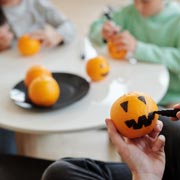 It’s also possible for children and families to create their own Halloween-themed decorations, with a bit of imagination. Stretched-out cotton wool can mimic spiders’ webs, for example. Children can get creative and make cut-out (with adult help for the youngest) spiders, bats, and suchlike to put on and around such webs. Children can paint oranges with faces to represent mini pumpkin Jack-O’-Lanterns, or even string these together into themed garlands. They can get involved in making Halloween-themed decorated biscuits or cookies too, which we’ll come to next.
It’s also possible for children and families to create their own Halloween-themed decorations, with a bit of imagination. Stretched-out cotton wool can mimic spiders’ webs, for example. Children can get creative and make cut-out (with adult help for the youngest) spiders, bats, and suchlike to put on and around such webs. Children can paint oranges with faces to represent mini pumpkin Jack-O’-Lanterns, or even string these together into themed garlands. They can get involved in making Halloween-themed decorated biscuits or cookies too, which we’ll come to next. Parents/carers can help children make, or simply decorate, Halloween-themed biscuits. See the photo to get an idea of how they can be baked and painted to represent wonderful ghosts, spider webs, bats and more. These are attractive as well as being great fun for little ones to get involved with, under supervision. What’s more, they can be eaten and are often delicious!
Parents/carers can help children make, or simply decorate, Halloween-themed biscuits. See the photo to get an idea of how they can be baked and painted to represent wonderful ghosts, spider webs, bats and more. These are attractive as well as being great fun for little ones to get involved with, under supervision. What’s more, they can be eaten and are often delicious! One of children’s favourite Halloween activities is dressing up. Children, including those under five, love to put on themed costumes to become a ghost, witch, wizard, spider, skeleton or character from a film like Harry Potter. Even better is when their friends, neighbours or siblings join in and they can each compare outfits and get into character. “Boo!” they may shout, or perhaps they’ll cast pretend spells and ‘fly’ on makeshift broomsticks. It’s all great fun!
One of children’s favourite Halloween activities is dressing up. Children, including those under five, love to put on themed costumes to become a ghost, witch, wizard, spider, skeleton or character from a film like Harry Potter. Even better is when their friends, neighbours or siblings join in and they can each compare outfits and get into character. “Boo!” they may shout, or perhaps they’ll cast pretend spells and ‘fly’ on makeshift broomsticks. It’s all great fun!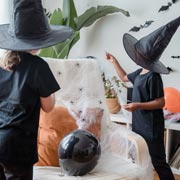 Outfits can be purchased, often inexpensively, online or through supermarkets when Halloween is approaching. Alternatively, children can get creative and make their own. A white sheet with suitable holes cut for eyes is perfect for a ghost outfit. Black material or capes are a great start for a witch or wizard outfit and pointy hats can be made, perhaps with a bit of help from adults, from cardboard and then painted black or covered with black tissue paper. Any number of different outfits can be made, in fact, and all that’s needed is imagination, the right materials, and a bit of time. Children’s creativity will be stimulated and they’ll get a great feeling of accomplishment once the fancy dress outfits are complete.
Outfits can be purchased, often inexpensively, online or through supermarkets when Halloween is approaching. Alternatively, children can get creative and make their own. A white sheet with suitable holes cut for eyes is perfect for a ghost outfit. Black material or capes are a great start for a witch or wizard outfit and pointy hats can be made, perhaps with a bit of help from adults, from cardboard and then painted black or covered with black tissue paper. Any number of different outfits can be made, in fact, and all that’s needed is imagination, the right materials, and a bit of time. Children’s creativity will be stimulated and they’ll get a great feeling of accomplishment once the fancy dress outfits are complete. All of the above activities can be combined when children throw a Halloween party for friends and/or neighbours. It’s all the more fun when other children come along in their own themed outfits. Together, children can play games, get into character, listen to spooky music, eat homemade Halloween-themed food and drinks, and have a wonderful time. Not only are parties fun but they also deepen bonds and help little children strengthen social skills. It’s all hugely creative too.
All of the above activities can be combined when children throw a Halloween party for friends and/or neighbours. It’s all the more fun when other children come along in their own themed outfits. Together, children can play games, get into character, listen to spooky music, eat homemade Halloween-themed food and drinks, and have a wonderful time. Not only are parties fun but they also deepen bonds and help little children strengthen social skills. It’s all hugely creative too. Part of the party could involve, perhaps, a ‘trick or treat’ session around the neighbourhood — under close supervision of one or more adults, of course. Children get great glee from this tradition, which often results in the bonus of lots of goodies to take home and sweets to eat (… and it’s only once a year) or perhaps a light-hearted, though often hilarious ‘scare’, should a neighbour decide to go with the ‘trick’ option.
Part of the party could involve, perhaps, a ‘trick or treat’ session around the neighbourhood — under close supervision of one or more adults, of course. Children get great glee from this tradition, which often results in the bonus of lots of goodies to take home and sweets to eat (… and it’s only once a year) or perhaps a light-hearted, though often hilarious ‘scare’, should a neighbour decide to go with the ‘trick’ option.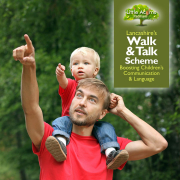
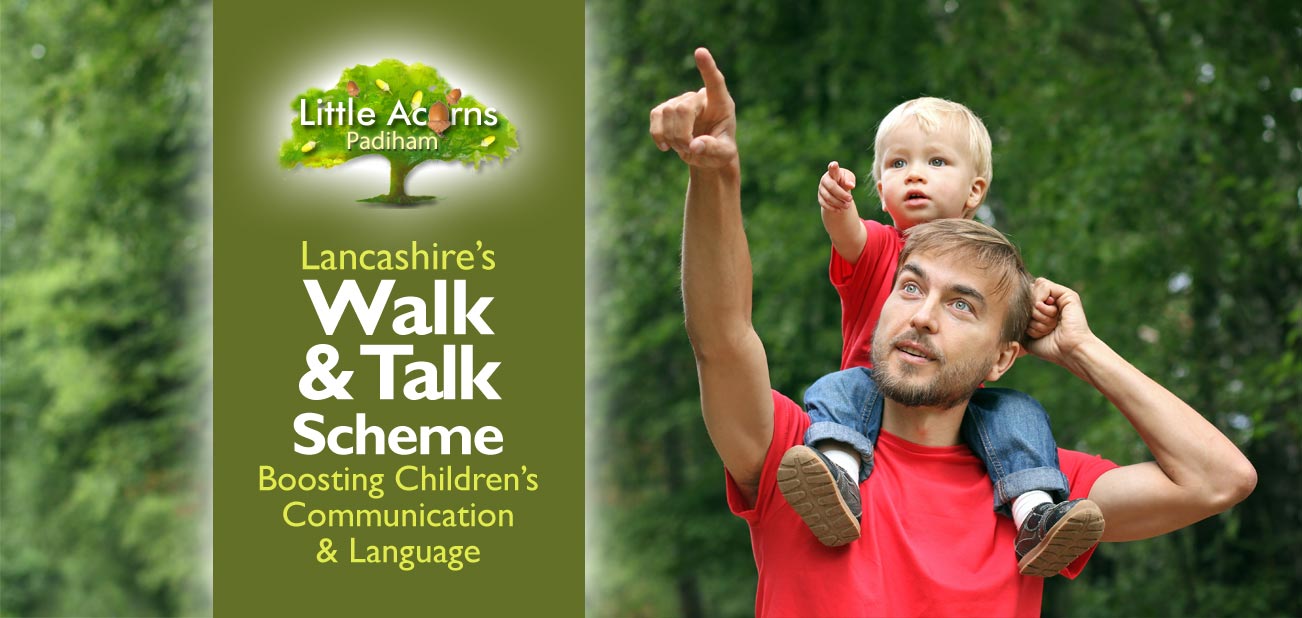
 Lancashire’s Walk & Talk Initiative is a scheme that’s wholeheartedly supported by the childcare practitioners at Little Acorns Nursery in Padiham. We encourage all Lancashire parents to take part too. It’s an initiative that is incredibly simple but has far-reaching benefits for children in their early years. Let’s take a look today at what Walk & Talk is all about, what its aims are, the benefits to children, and how families can get involved.
Lancashire’s Walk & Talk Initiative is a scheme that’s wholeheartedly supported by the childcare practitioners at Little Acorns Nursery in Padiham. We encourage all Lancashire parents to take part too. It’s an initiative that is incredibly simple but has far-reaching benefits for children in their early years. Let’s take a look today at what Walk & Talk is all about, what its aims are, the benefits to children, and how families can get involved.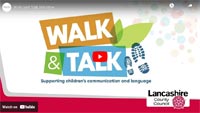
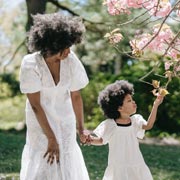 a reduction in the ‘word gap’ — helping children learn new words and widen vocabulary;
a reduction in the ‘word gap’ — helping children learn new words and widen vocabulary;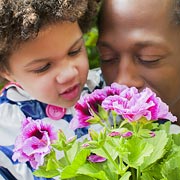 The scheme also aims to encourage children to use a variety of senses. These include, for example, sight, smell, touch, taste, hearing and, of course, active listening. When out on walks there are so many different things for children’s senses to be stimulated by and each lends itself to a conversation. Whether it’s the sound of birdsong, the feeling of the wind on their faces, the smell of freshly-cut grass on the breeze, the noise of traffic, the dazzlingly beautiful colours of blossom, or the mouth-watering smell of food cooking around the neighbourhood or town, walking is indeed a feast for the senses.
The scheme also aims to encourage children to use a variety of senses. These include, for example, sight, smell, touch, taste, hearing and, of course, active listening. When out on walks there are so many different things for children’s senses to be stimulated by and each lends itself to a conversation. Whether it’s the sound of birdsong, the feeling of the wind on their faces, the smell of freshly-cut grass on the breeze, the noise of traffic, the dazzlingly beautiful colours of blossom, or the mouth-watering smell of food cooking around the neighbourhood or town, walking is indeed a feast for the senses.
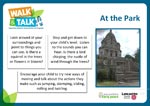
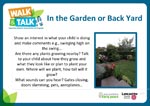
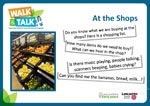
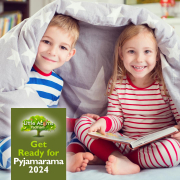
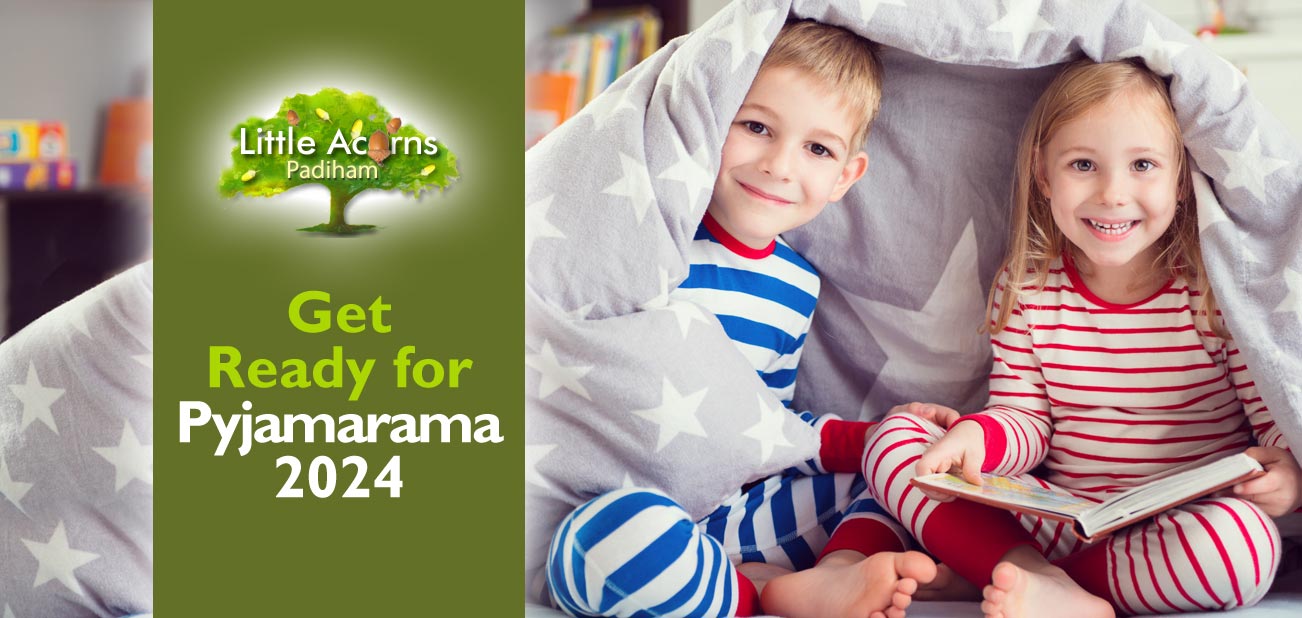
 Pyjamarama is a one-day fundraising event that’s organised through the children’s reading charity BookTrust. It takes place each year across a variety of UK settings including homes, schools, preschools, nurseries and more. As well as being great fun for those organising and taking part, the initiative is beneficial to millions of disadvantaged children. The ultimate aim is to raise money to fund the purchase of books and resources, so that every child in the UK gets the chance for bedtime stories and each family has proper reading opportunities. The initiative is hugely popular, great fun, and transforms lives. Today, we take a look at what to expect, how to get involved, and the many benefits of Pyjamarama.
Pyjamarama is a one-day fundraising event that’s organised through the children’s reading charity BookTrust. It takes place each year across a variety of UK settings including homes, schools, preschools, nurseries and more. As well as being great fun for those organising and taking part, the initiative is beneficial to millions of disadvantaged children. The ultimate aim is to raise money to fund the purchase of books and resources, so that every child in the UK gets the chance for bedtime stories and each family has proper reading opportunities. The initiative is hugely popular, great fun, and transforms lives. Today, we take a look at what to expect, how to get involved, and the many benefits of Pyjamarama. Pyjamarama is always a fun day for both adults and children. The added aspect of pyjamas makes it special, quirky and relaxed. And, at the end of the day, it’s incredibly worthwhile. Not only does it raise money to give disadvantaged children and their families opportunities for reading and bedtime stories, but it also encourages those children taking part in Pyjamarama to read more, for pleasure as much as anything. Additionally, it gives children a different perspective and encourages altruism and empathy for others less fortunate than themselves.
Pyjamarama is always a fun day for both adults and children. The added aspect of pyjamas makes it special, quirky and relaxed. And, at the end of the day, it’s incredibly worthwhile. Not only does it raise money to give disadvantaged children and their families opportunities for reading and bedtime stories, but it also encourages those children taking part in Pyjamarama to read more, for pleasure as much as anything. Additionally, it gives children a different perspective and encourages altruism and empathy for others less fortunate than themselves.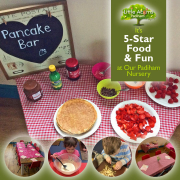
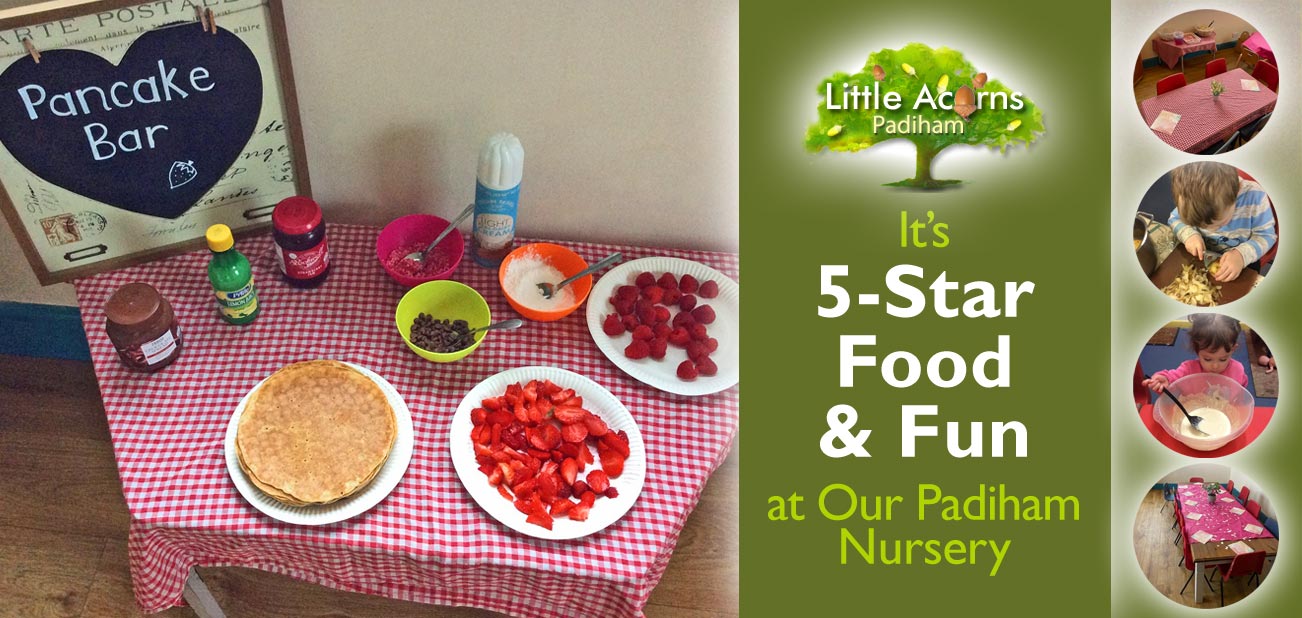
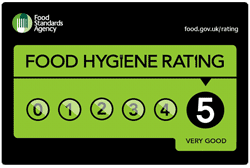 Our Padiham nursery had its annual inspection by the local Environmental Health Officer recently. The purpose was to ensure, as required in all settings serving food, that Little Acorns Nursery has high standards of hygiene and follows the food preparation guidelines specified by the UK’s Food Standards Agency. Once again, Little Acorns Nursery passed with flying colours, achieving a full 5-star rating. That’s the best rating possible and reflects the highest levels of quality for food preparation, the food itself, cleanliness, and competence of staff. So, our thanks and utmost respect go to Kim, our in-house chef/cook, whose high standards, skill and expertise do the children and the nursery proud.
Our Padiham nursery had its annual inspection by the local Environmental Health Officer recently. The purpose was to ensure, as required in all settings serving food, that Little Acorns Nursery has high standards of hygiene and follows the food preparation guidelines specified by the UK’s Food Standards Agency. Once again, Little Acorns Nursery passed with flying colours, achieving a full 5-star rating. That’s the best rating possible and reflects the highest levels of quality for food preparation, the food itself, cleanliness, and competence of staff. So, our thanks and utmost respect go to Kim, our in-house chef/cook, whose high standards, skill and expertise do the children and the nursery proud.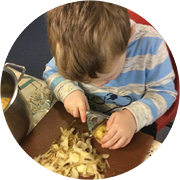 Because the recipe heavily involved potatoes, this also tied in nicely with the book Supertato, which our preschoolers have been looking at in tandem with discussions about food and the importance of a healthy diet. The photo shows one of the children peeling potatoes. Others peeled vegetables and even made their own dumplings. The fun activity helped to nurture children’s learning and the development of new skills and knowledge. The final result was both tasty and a huge hit with the little ones!
Because the recipe heavily involved potatoes, this also tied in nicely with the book Supertato, which our preschoolers have been looking at in tandem with discussions about food and the importance of a healthy diet. The photo shows one of the children peeling potatoes. Others peeled vegetables and even made their own dumplings. The fun activity helped to nurture children’s learning and the development of new skills and knowledge. The final result was both tasty and a huge hit with the little ones!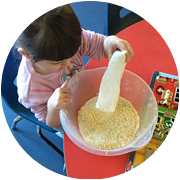 Shrove Tuesday, a.k.a. Pancake Day, arrived on the 13th of February and it gave us a great opportunity to organise pancake-themed activities for the nursery/preschool children … for the entire week! After all, who doesn’t love pancakes? So, as you’ve no doubt guessed by now, our Recipe of the Month for February was home-made pancakes and it’s a recipe the children really enjoyed getting involved in. They loved mixing ingredients in a bowl to make their own pancake mix. We even set up a ‘Pancake Bar’ (see the main photo at the top), which included lots of yummy toppings that children could use to decorate their pancakes. The toppings included strawberries, bananas, chocolate spread, jam, lemon, sprinkles, honey and cream.
Shrove Tuesday, a.k.a. Pancake Day, arrived on the 13th of February and it gave us a great opportunity to organise pancake-themed activities for the nursery/preschool children … for the entire week! After all, who doesn’t love pancakes? So, as you’ve no doubt guessed by now, our Recipe of the Month for February was home-made pancakes and it’s a recipe the children really enjoyed getting involved in. They loved mixing ingredients in a bowl to make their own pancake mix. We even set up a ‘Pancake Bar’ (see the main photo at the top), which included lots of yummy toppings that children could use to decorate their pancakes. The toppings included strawberries, bananas, chocolate spread, jam, lemon, sprinkles, honey and cream.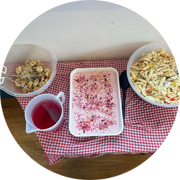 Valentine’s Day, which arrived on the 14th of February, also involved lots of food. After all, as the saying goes, it is often thought of as the language of love! At the nursery, we organised a lovely Grab ‘n’ Go Breakfast for our parents. This was followed by a special 3-course Valentine’s Day meal for our children in our lovely new dining room, which was set up like a little restaurant (see the photos). Children had sausage rolls to start, cheesy chicken and red pepper pasta for the main course and strawberry mousse – with sprinkles – for pudding. Accompanying this was some delicious blackcurrant juice. It all went down a treat with our nursery children, as did several other activities that were themed towards Valentine’s Day.
Valentine’s Day, which arrived on the 14th of February, also involved lots of food. After all, as the saying goes, it is often thought of as the language of love! At the nursery, we organised a lovely Grab ‘n’ Go Breakfast for our parents. This was followed by a special 3-course Valentine’s Day meal for our children in our lovely new dining room, which was set up like a little restaurant (see the photos). Children had sausage rolls to start, cheesy chicken and red pepper pasta for the main course and strawberry mousse – with sprinkles – for pudding. Accompanying this was some delicious blackcurrant juice. It all went down a treat with our nursery children, as did several other activities that were themed towards Valentine’s Day.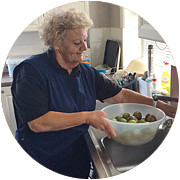 Kim, our talented in-house chef, prepares tasty home-made meals and healthy snacks for children at the nursery. Meals are prepared freshly, on site, using high-quality ingredients, which are locally sourced whenever possible. They are delicious as well as being nutritionally balanced to include a healthy mix of fish, meat, pulses and vegetables.
Kim, our talented in-house chef, prepares tasty home-made meals and healthy snacks for children at the nursery. Meals are prepared freshly, on site, using high-quality ingredients, which are locally sourced whenever possible. They are delicious as well as being nutritionally balanced to include a healthy mix of fish, meat, pulses and vegetables. 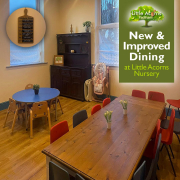
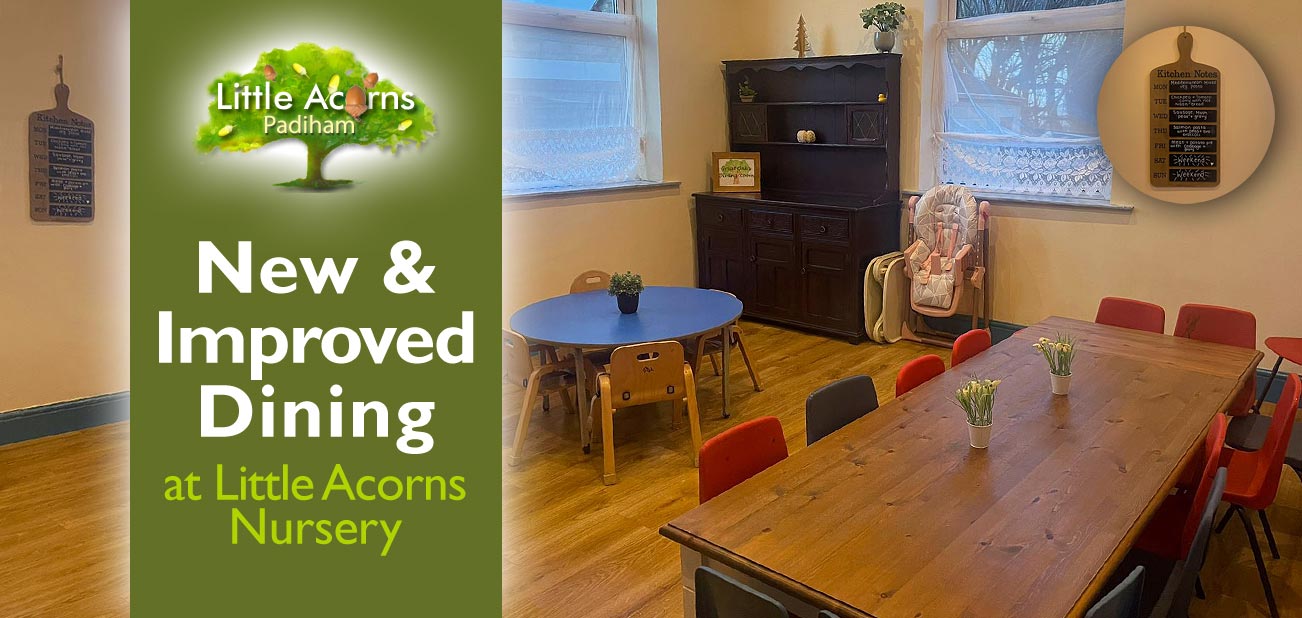
 To make way for the new children’s dining room, an existing room at the setting was repurposed and totally revamped. Starting in Summer 2023, the contents of the existing room were sorted and relocated where needed, leaving a wonderful new space to use as the new ‘Great Oaks’ dining room. Walls, ceilings and skirting boards were prepared and freshened up with new paint. Attractive William Morris-style wallpaper was also hung on a ‘feature’ wall. Large canvas wall images were displayed to form interesting focal points and storage was added in the form of a large cabinet and a small cupboard. Large and small dining room tables and chairs were added for the different age groups along with high chairs, which will be close at hand whenever needed. All this sits on a durable floor with an attractive wood finish. All in all, the outcome is a pleasant home-from-home for children.
To make way for the new children’s dining room, an existing room at the setting was repurposed and totally revamped. Starting in Summer 2023, the contents of the existing room were sorted and relocated where needed, leaving a wonderful new space to use as the new ‘Great Oaks’ dining room. Walls, ceilings and skirting boards were prepared and freshened up with new paint. Attractive William Morris-style wallpaper was also hung on a ‘feature’ wall. Large canvas wall images were displayed to form interesting focal points and storage was added in the form of a large cabinet and a small cupboard. Large and small dining room tables and chairs were added for the different age groups along with high chairs, which will be close at hand whenever needed. All this sits on a durable floor with an attractive wood finish. All in all, the outcome is a pleasant home-from-home for children.